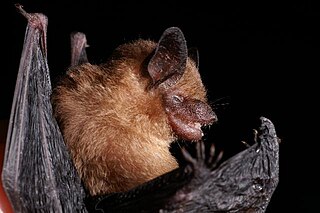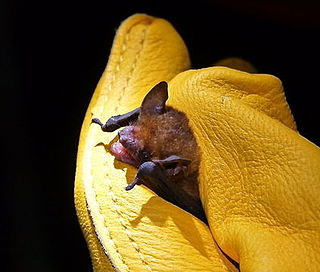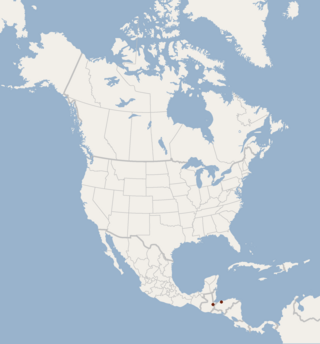
The black-winged little yellow bat is a species of vesper bat native to Central America.
The Bibundi bat is a species of vesper bat in the family Vespertilionidae. It can be found in Cameroon, Republic of the Congo, Uganda, and the Dzanga-Sangha Special Reserve.

Allen's yellow bat is a species of vesper bat. There is some taxonomic debate surrounding this species, with some authors considering Baeodon a genus rather than a subgenus. It is endemic to Mexico.

Genoways's yellow bat is a species of vesper bat found only in Mexico. It is threatened by habitat loss. Due to its imperiled status, it is identified by the Alliance for Zero Extinction as a species in danger of imminent extinction.

The slender yellow bat is a species of vesper bat. It is found only in Mexico. It ranges from Jalisco and Zacatecas to Oaxaca states, where it has been found in pine and pine-oak forests, tropical dry forest, and dry shrublands from 600 to 2,000 meters elevation.

The tiny yellow bat is a species of vesper bat. It is found in Colombia and Venezuela.

The least yellow bat is a species of vesper bat found only in Mexico.

The little yellow bat is a species of vesper bat found only in Mexico.

The lesser Asiatic yellow bat is a species of vesper bat. It is found in Bangladesh, Cambodia, India, Indonesia, Malaysia, Pakistan, the Philippines, Sri Lanka, and Taiwan.

Van Gelder's bat or Van Gelder's big-eared bat is a species of vesper bat in the family Vespertilionidae. It is found in Belize, Costa Rica, Honduras, and Mexico. The species is monotypic within its genus. It is part of the tribe Antrozoini within the subfamily Vespertilioninae and is related to the pallid bat. The bat is found in forest habitat from sea level to elevations as high as 2300 m, although not usually above 1300 m, and is insectivorous and crepuscular. It apparently has a fragmented distribution, and is threatened by deforestation.

The lesser yellow-shouldered bat is a species of bat in the family Phyllostomidae. It is native to Peru and Ecuador. It is threatened by habitat loss.

The Vespertilioninae are a subfamily of vesper bats from the family Vespertilionidae.

Rhogeessa is a genus of bats within the vesper bats family, Vespertilionidae.

The pond bat is a species of vesper bat. It is found in Eurasia from France to Russia and Kazakhstan.

Thomas's yellow bat is a species of bat from the family Vespertilionidae.

Thomas's big-eared brown bat is a species of vesper bat found in South America.

Menchu's little yellow bat is a species of vesper bat found in Central America. It was described as a new species in 2012.

The Malagasy yellow bat, sometimes known as the western yellow bat, is a species of vesper bat endemic to Madagascar.
Rhogeessa velilla, also called the Ecuadorian little yellow bat, is a species of vesper bat in the genus Rhogeessa. It is found in Northwestern Peru and parts of Ecuador. The species was previously included in R. io, but is now recognized as a separate species. Very little is known about this species, though it is generally considered to be insectivorous.


















